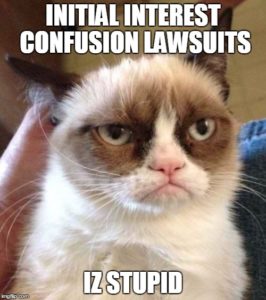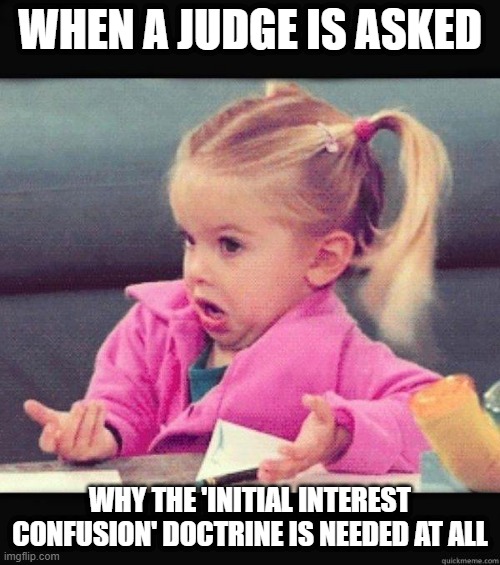‘Initial Interest Confusion’ Is More of a Vibe Than a Credible Legal Doctrine–Penn State v. Vintage Brand
This is a merchandise “counterfeiting” case. In a prior ruling in this case, a “jury determined that Defendants had willfully violated Penn State’s trademark and awarded Penn State $28,000 in compensatory damages.” The defendants challenged the jury results, including Penn State’s references to initial interest confusion when it wasn’t part of their legal theory. In response, the judge issues a confusing throwback opinion where it becomes clear that initial interest confusion is better thought of as a vibe rather than as a credible legal doctrine.
What does the term “initial interest confusion” even mean? I don’t have a good answer to that question, and this court doesn’t either:
The Court rejects Defendants’ argument that…initial-interest confusion in particular requires intentional deception. Rather, within the Third Circuit, Penn State is correct that the various types of confusion are not separate claims but, rather, merely separate ways of demonstrating confusion and are all analyzed “within the context of the relevant Lapp factors.”
If the court’s position is that initial interest confusion doesn’t provide a bypass to the standard likelihood-of-consumer-confusion factors, but rather an analytical tool that supports the multi-factor analysis, exactly what do the IIC principles add to that multi-factor analysis?
The court continues:
the Third Circuit has previously examined evidence related initial interest confusion and, in conducting that analysis, has treated an intent to deceive as relevant to the confusion inquiry, but not dispositive or required.
Intent to deceive is an express factor in the Lapp test (#5: “the intent of the defendant in adopting the mark”). IIC could provide evidence to support (or, in theory, refute) the fifth Lapp factor. Or–hear me out–whatever facts purportedly support the IIC assertion could be cited as evidence of this fifth factor directly, without referencing the IIC term at all. As usual, the IIC doctrine adds nothing to this analysis.
The court continues:
As to initial interest confusion, both parties note that one witness performed a Google search that brought up Vintage Brand products alongside officially licensed products, and that the witness did not see any indication that Vintage Brand was not an authorized retailer of Penn State merchandise. Certainly, this evidence is neither overwhelming nor particularly strong. But this evidence is sufficient, when viewed most favorably to Penn State, to support a jury determination that these results were confusing.
 Oh my gosh, I can’t believe we’re still doing this. I argued we should disregard purported consumer confusion about search results back in…2005. For a fun (?) trip down memory lane, read my 90 page discourse on why it’s stupid to treat consumer confusion about search results as relevant to the legal inquiry into the likelihood of consumer confusion about the source of goods and services in the marketplace. It’s 2025 FFS–have we learned nothing about this topic in the past 20 years?
Oh my gosh, I can’t believe we’re still doing this. I argued we should disregard purported consumer confusion about search results back in…2005. For a fun (?) trip down memory lane, read my 90 page discourse on why it’s stupid to treat consumer confusion about search results as relevant to the legal inquiry into the likelihood of consumer confusion about the source of goods and services in the marketplace. It’s 2025 FFS–have we learned nothing about this topic in the past 20 years?
Distinguishing the very old Tabari v. Toyota case (a domain name case! from 2010! by Judge Kozinski, who resigned from the bench under a dark cloud eight years ago), the court says:
there is evidence that even a wary consumer without any expectations of the website that they visited would have been confused by the search results presented—and that such confusion would not have been dispelled by Vintage Brand’s website. For example, Penn State’s expert testified that there were high levels of confusion associated with Vintage Brand’s website (or at least excised portions of the website) and “a substantial risk that people will think that Penn State has either made, sponsored, is affiliated with, or is approving of the — of the merchandise that Vintage Brands [sic] is selling.” Similarly, Defendants’ expert testified to high levels of gross confusion, although the net confusion numbers were significantly lower. Finally, deposition testimony was played for the jury wherein a witness for Penn State asserted that she believed, based on Vintage Brand’s website, that it was authorized to use Penn State trademarks on its products
If the confusion is being caused by the complained-about website after a consumer clicks on a search result, what does the IIC doctrine have to do with any of this analysis? It seems like the court opinion could have been written identically without ever using the term “initial interest confusion.”
The judge ends the opinion with an invitation to the Third Circuit to fix various doctrinal problems on appeal. That sounds like a good idea. Let’s start by emphatically putting an end to the IIC nonsense.
Case Citation: Pennsylvania State University v. Vintage Brand LLC, 2025 WL 3048996 (M.D. Penn. Oct. 31, 2025). The GovInfo page.



Pingback: The Initial Interest Confusion Doctrine Refuses to Die - Technology & Marketing Law Blog()